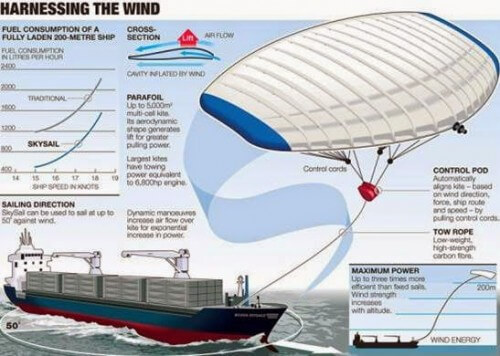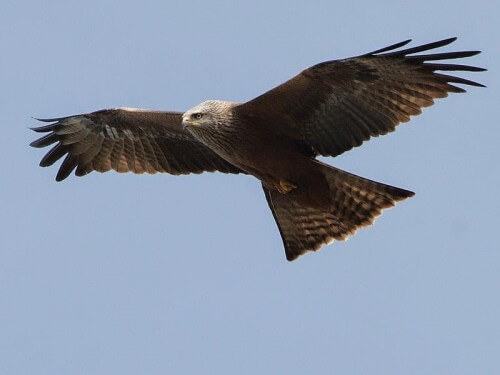A kite sail, which has an area of between 3 and 5 dunams and has a rounded structure like a Daya wing, tows and sails ships with a size of 50,000 tons and more, contributes to the protection of the environment and produces a reduction in the consumption of expendable (degradable) energy at a rate between 30% and 300%.

By: Shimon Bogan
Wind and ink, kites and ships are connected today more than ever. When we were children we made kites, we sent them with the wind to the sky, we wove a thread that connects dreams about distances and spaces and we sang "... and we will be like birds". But doves don't fly far away with the wind, and the required rhyming connection should have been for "a wing like enough", but demons were foreign to the children of the kindergartens in Jerusalem. Inks were seen only in Carmel and the Galilee.
We learned the etymology of the bird's name from Rishi according to the Torah and the Gemara - "She saw, she is, she is daa, she is enough". The sages of Israel during the Mishna period knew how to observe nature, to connect in thought and action to the phenomena on the ground, in the water and in the sky, in the living, in the plant and in the inanimate, and among other things to instill in us the connection of daya to daya. A photo search of Daya / Milvus on the net will return you spectacular photographs of the configuration of the wings in Daya.
We learn about the presence of Deiya in the territories of Israel in very ancient times from the claim that fossilized remains of Deiya from the Pleistocene period were found at a prehistoric site, the oldest in the Middle East, near Beit Zera in the Jordan Valley. *

The continuation derives from the lexical combination of Diya and Kite: Diya in Hebrew is called KITE in English. KITE in English is called a kite in Hebrew.
The ancient Chinese also observed mainly birds of prey, humming and flying with the wind in their hunt for prey and their migration. The Chinese were the first to learn to imitate the birds that hum and float with the wind. They built kites starting from the 8th century BC not for the purposes of play, amusement or sport, but to use wind energy for military needs of observation and communication for the armies of the emperors. The very large kites successfully carried a fighting man for many hours. You should see link (1).
Since then, the Chinese have excelled in the construction and display of ceremonial kites, not forgetting to pay respect to the source of inspiration. You should see link (2).
The wind is included among the renewable energy sources. The energy utilization potential of bromine winds at 1,000 meters above sea level and at constant speeds of 100 km/h is 16 times greater, by 1500%, than the energy utilization potential of large wind turbines, which rise up to a height of about 150 meters, a height where the constant wind speed is around 40 km/h only. For some time scientists and engineers have been searching for and developing means to produce alternative energy from the fast and strong winds that blow at high altitude (high altitude wind energy, HAWE). You should see link (3).
A kite sail, which has an area of between 3 and 5 dunams and has a rounded structure like a Daya wing, tows and sails ships with a size of 50,000 tons and more, contributes to the protection of the environment and produces a reduction in the consumption of expendable (degradable) energy at a rate between 30% and 300%.
The excellent description below was given by SkySail Germany:
Photographs of merchant ships, tankers, ships, etc., powered by a kite-sail, should be seen in links (4), (5) and (6).
That's why they said from now on a ship, a ship, with a wing like enough.
* Children's song, Teresa Gottlieb Guitein, Jerusalem 1933
Sources
http://www.chinaculture.org/gb/en_chinaway/2005-07/14/content_70609_2.htm (1)
http://www.my-best-kite.com/history-of-kites.html (2)
http://www.windustry.org/wind-basics (3)
http://www.mng.org.uk/gh/transport/NS_new_age_of_sail.htm (4)
http://www.skysails.info/english/ Europe (5)

2 תגובות
And what happens when the sailing course is against the direction of the wind? What happens when there is no wind at all?
Why do we need Hebrew poems, a history of the childhood of the writer Mim, and the history of Deya in the "Hidan" article??
Who cares? All this to explain why ships use wind energy to move??
Big ships use huge sails, so what is the novelty of adding a spinnaker sail to a ship?
This is a very low level article! Looks like a post from a bored person from Facebook
The problem with a kite sail is when the wind stops for a moment or changes direction the kite falls into the sea
Taking a 5 dunam kite out of the sea and spreading it again is only possible with cranes